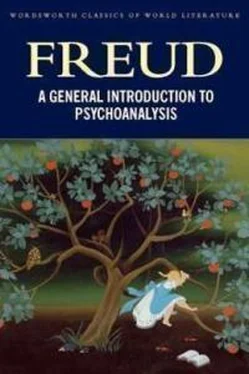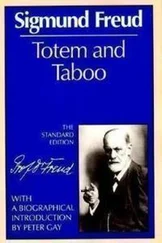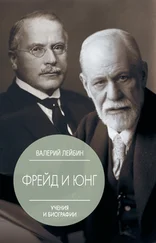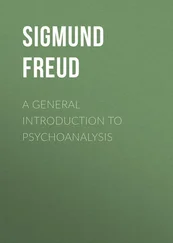You have probably noticed the ambiguity and vagueness in the use of the word "anxiety." Generally one means a subjective condition, caused by the perception that an "evolution of fear" has been consummated. Such a condition may be called an emotion. What is an emotion in the dynamic sense? Certainly something very complex. An emotion, in the first place, includes indefinite motor innervations or discharges; secondly, definite sensations which moreover are of two kinds, the perception of motor activities that have already taken place, and the direct sensations of pleasure and pain, which give the effect of what we call its feeling tone. But I do not think that the true nature of the emotion has been fathomed by these enumerations. We have gained deeper insight into some emotions and realize that the thread which binds together such a complex as we have described is the repetition of a certain significant experience. This experience might be an early impression of a very general sort, which belongs to the antecedent history of the species rather than to that of the individual. To be more clear: the emotional condition has a structure similar to that of an hysterical attack; it is the upshot of a reminiscence. The hysteric attack, then, is comparable to a newly formed individual emotion, the normal emotion to an hysteria which has become a universal heritage.
Do not assume that what I have said here about emotions is derived from normal psychology. On the contrary, these are conceptions that have grown up with and are at home only in psychoanalysis. What psychology has to say about emotions—the James–Lange theory, for instance—is absolutely incomprehensible for us psychoanalysts, and cannot be discussed. Of course, we do not consider our knowledge about emotions very certain; it is a preliminary attempt to become oriented in this obscure region. To continue: We believe we know the early impression which the emotion of fear repeats. We think it is birth itself which combines that complex of painful feelings, of a discharge of impulses, of physical sensations, which has become the prototype for the effect of danger to life, and is ever after repeated within us as a condition of fear. The tremendous heightening of irritability through the interruption of the circulation (internal respiration) was at the time the cause of the experience of fear; the first fear was therefore toxic. The name anxiety—angustial—narrowness, emphasizes the characteristic tightening of the breath, which was at the time a consequence of an actual situation and is henceforth repeated almost regularly in the emotion. We shall also recognize how significant it is that this first condition of fear appeared during the separation from the mother. Of course, we are convinced that the tendency to repetition of the first condition of fear has been so deeply ingrained in the organism through countless generations, that not a single individual can escape the emotion of fear; not even the mythical Macduff who was "cut out of his mother's womb," and therefore did not experience birth itself. We do not know the prototype of the condition of fear in the case of other mammals, and so we do not know the complex of emotions that in them is the equivalent of our fear.
Perhaps it will interest you to hear how the idea that birth is the source and prototype of the emotion of fear, happened to occur to me. Speculation plays the smallest part in it; I borrowed it from the native train of thought of the people. Many years ago we were sitting around the dinner table—a number of young physicians—when an assistant in the obstetrical clinic told a jolly story of what had happened in the last examination for midwives. A candidate was asked what it implied if during delivery the foeces of the newborn was present in the discharge of waters, and she answered promptly "the child is afraid." She was laughed at and "flunked." But I silently took her part and began to suspect that the poor woman of the people had, with sound perception, revealed an important connection.
Proceeding now to neurotic fear, what are its manifestations and conditions? There is much to be described. In the first place we find a general condition of anxiety, a condition of free–floating fear as it were, which is ready to attach itself to any appropriate idea, to influence judgment, to give rise to expectations, in fact to seize any opportunity to make itself felt. We call this condition "expectant fear" or "anxious expectation." Persons who suffer from this sort of fear always prophesy the most terrible of all possibilities, interpret every coincidence as an evil omen, and ascribe a dreadful meaning to all uncertainty. Many persons who cannot be termed ill show this tendency to anticipate disaster. We blame them for being over–anxious or pessimistic. A striking amount of expectant fear is characteristic of a nervous condition which I have named "anxiety neurosis," and which I group with the true neuroses.
A second form of fear in contrast to the one we have just described is psychologically more circumscribed and bound up with certain objects or situations. It is the fear of the manifold and frequently very peculiar phobias. Stanley Hall, the distinguished American psychologist, has recently taken the trouble to present a whole series of these phobias in gorgeous Greek terminology. They sound like the enumeration of the ten Egyptian plagues, except that their number exceeds ten, by far. Just listen to all the things which may become the objects of contents of a phobia: Darkness, open air, open squares, cats, spiders, caterpillars, snakes, mice, thunder–storms, sharp points, blood, enclosed spaces, crowds, solitude, passing over a bridge, travel on land and sea, etc. A first attempt at orientation in this chaos leads readily to a division into three groups. Some of the fearful objects and situations have something gruesome for normal people too, a relation to danger, and so, though they are exaggerated in intensity, they do not seem incomprehensible to us. Most of us, for instance, experience a feeling of repulsion in the presence of a snake. One may say that snakephobia is common to all human beings, and Charles Darwin has described most impressively how he was unable to control his fear of a snake pointing for him, though he knew he was separated from it by a thick pane of glass. The second group consists of cases which still bear a relation to danger, but this is of a kind which we are disposed to belittle rather than to overestimate. Most of the situation–phobia belong here. We know that by taking a railroad journey we entail greater chance of disaster than by staying at home. A collision, for instance, may occur, or a ship sink, when as a rule we must drown; yet we do not think of these dangers, and free from fear we travel on train and boat. We cannot deny that if a bridge should collapse at the moment we are crossing it, we would fall into the river, but that is such a rare occurrence that we do not take the danger into account. Solitude too has its dangers and we avoid it under certain conditions; but it is by no means a matter of being unable to suffer it for a single moment. The same is true for the crowd, the enclosed space, the thunder–storm, etc. It is not at all the content but the intensity of these neurotic phobias that appears strange to us. The fear of the phobia cannot even be described. Sometimes we almost receive the impression that the neurotic is not really afraid of the same things and situations that can arouse fear in us, and which he calls by the same name.
There remains a third group of phobias which is entirely unintelligible to us. When a strong, adult man is afraid to cross a street or a square of his own home town, when a healthy, well–developed woman becomes almost senseless with fear because a cat has brushed the hem of her dress or a mouse has scurried through the room—how are we to establish the relation to danger that obviously exists under the phobia? In these animal phobias it cannot possibly be a question of the heightening of common human antipathies. For, as an illustration of the antithesis, there are numerous persons who cannot pass a cat without calling and petting it. The mouse of which women are so much afraid, is at the same time a first class pet name. Many a girl who has been gratified to have her lover call her so, screams when she sees the cunning little creature itself. The behavior of the man who is afraid to cross the street or the square can only be explained by saying that he acts like a little child. A child is really taught to avoid a situation of this sort as dangerous, and our agoraphobist is actually relieved of his fear if some one goes with him across the square or street.
Читать дальше







